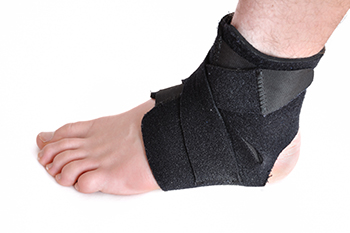Connect With Us
Blog
Items filtered by date: September 2023
Preventive Measures for Toenail Fungus

Toenail fungus, also known as onychomycosis, is a common condition that affects countless individuals worldwide. It occurs when fungi, often dermatophytes, enter the nail bed through tiny cracks or cuts in the skin, leading to an infection. The resulting symptoms typically include thickened, discolored nails that may become brittle or crumble over time. Recognizing toenail fungus is essential, as early intervention can prevent further complications. Apart from the visual signs, you may also experience mild pain or discomfort, especially when wearing tight-fitting shoes. To help prevent toenail fungus, it is important to practice proper foot hygiene, such as regularly washing and drying your feet thoroughly. Since fungi thrive in damp environments, be sure your shoes are well-ventilated and moisture-wicking. Additionally, it is beneficial to avoid walking barefoot in public areas, including locker rooms and swimming pools, where the risk of infection is higher. Trimming the nails straight across can also help prevent ingrown nails and potential entry points for fungus. If you suspect you have toenail fungus, it is suggested that you seek prompt treatment from a podiatrist who can offer you treatment methods that are right for you.
For more information about treatment, contact one of our podiatrists of New England Foot and Ankle. Our doctors can provide the care you need to keep you pain-free and on your feet.
Toenail Fungus Treatment
Toenail fungus is a condition that affects many people and can be especially hard to get rid of. Fortunately, there are several methods to go about treating and avoiding it.
Antifungals & Deterrence
Oral antifungal medicine has been shown to be effective in many cases. It is important to consult with a podiatrist to determine the proper regiment for you, or potentially explore other options.
Applying foot powder on the feet and shoes helps keep the feet free of moisture and sweat.
Sandals or open toed shoes – Wearing these will allow air movement and help keep feet dry. They also expose your feet to light, which fungus cannot tolerate. Socks with moisture wicking material also help as well.
If you have any questions please feel free to contact one of our offices located in Chelmsford and Newburyport, MA . We offer the newest diagnostic tools and technology to treat your foot and ankle needs.
Causes of Ankle Instability

Ankle instability can be a persistent and troublesome issue for many people, affecting their daily activities and overall quality of life. It often arises due to a variety of factors that compromise the stability of the ankle joint. One common cause of ankle instability is a history of ankle sprains. When an ankle is sprained, the ligaments that support it may stretch or tear, weakening its ability to hold the joint in place. Muscle weakness is another contributing factor, as insufficient strength in the muscles surrounding the ankle can increase the joint’s instability. Additionally, certain medical conditions, such as ligament laxity and joint hypermobility, can predispose individuals to ankle instability. Improper footwear choices, especially high heels or shoes lacking adequate support, can also strain the ankle joint over time. Finally, biomechanical issues like overpronation or supination can create an imbalance, which further increases the risk of ankle instability. If you're experiencing ankle instability, it is suggested that you make an appointment with a podiatrist for a personalized assessment and guidance on managing your condition.
Ankle pain can be caused by a number of problems and may be potentially serious. If you have ankle pain, consult with one of our podiatrists from New England Foot and Ankle. Our doctors will assess your condition and provide you with quality foot and ankle treatment.
Ankle pain is any condition that causes pain in the ankle. Due to the fact that the ankle consists of tendons, muscles, bones, and ligaments, ankle pain can come from a number of different conditions.
Causes
The most common causes of ankle pain include:
- Types of arthritis (rheumatoid, osteoarthritis, and gout)
- Ankle sprains
- Broken ankles
- Achilles tendinitis
- Achilles tendon rupture
- Stress fractures
- Bursitis
- Tarsal tunnel syndrome
- Plantar fasciitis
Symptoms
Symptoms of ankle injury vary based upon the condition. Pain may include general pain and discomfort, swelling, aching, redness, bruising, burning or stabbing sensations, and/or loss of sensation.
Diagnosis
Due to the wide variety of potential causes of ankle pain, podiatrists will utilize a number of different methods to properly diagnose ankle pain. This can include asking for personal and family medical histories and of any recent injuries. Further diagnosis may include sensation tests, a physical examination, and potentially x-rays or other imaging tests.
Treatment
Just as the range of causes varies widely, so do treatments. Some more common treatments are rest, ice packs, keeping pressure off the foot, orthotics and braces, medication for inflammation and pain, and surgery.
If you have any questions, please feel free to contact one of our offices located in Chelmsford and Newburyport, MA . We offer the newest diagnostic and treatment technologies for all your foot care needs.
Wounds That Don't Heal Need to Be Checked
Bunion Surgery May Help Provide Pain-Free Feet

Bunions, those painful bony bumps that form at the base of the big toe, can be a source of immense discomfort and self-consciousness. When conservative measures fail to provide relief, bunion surgery may become a viable option. Medically known as a bunionectomy, this surgical procedure aims to correct the misalignment of the big toe joint, eliminating pain and improving foot function. During the surgery, the podiatrist will remove the bony bump and realign the bones and tissues to their proper position. Recovery may take several weeks, during which weight must be kept off the affected foot. It is important to follow post-operative care instructions diligently. While bunion surgery is a significant step, it offers a promising path toward a life free from the pain and inconvenience of bunions, allowing you to walk comfortably and confidently once again. If you have a bunion, it is suggested that you consult with a podiatrist who can determine if surgery is correct for you.
Foot surgery is sometimes necessary to treat a foot ailment. To learn more, contact one of our podiatrists of New England Foot and Ankle. Our doctors will assist you with all of your foot and ankle needs.
When Is Surgery Necessary?
Foot and ankle surgery is generally reserved for cases in which less invasive, conservative procedures have failed to alleviate the problem. Some of the cases in which surgery may be necessary include:
- Removing foot deformities like bunions and bone spurs
- Severe arthritis that has caused bone issues
- Cosmetic reconstruction
What Types of Surgery Are There?
The type of surgery you receive will depend on the nature of the problem you have. Some of the possible surgeries include:
- Bunionectomy for painful bunions
- Surgical fusion for realignment of bones
- Neuropathy decompression surgery to treat nerve damage
Benefits of Surgery
Although surgery is usually a last resort, it can provide more complete pain relief compared to non-surgical methods and may allow you to finally resume full activity.
Surgical techniques have also become increasingly sophisticated. Techniques like endoscopic surgery allow for smaller incisions and faster recovery times.
If you have any questions please feel free to contact one of our offices located in Chelmsford and Newburyport, MA . We offer the newest diagnostic and treatment technologies for all your foot and ankle needs.
Definition and Causes of Bunions

Bunions are bony protrusions at the base of the big toe and are more than just a foot concern as they can impact daily comfort and mobility. Medically known as hallux valgus, bunions develop gradually as the top of the big toe leans toward the second toe, causing the joint to jut out. Genetics play a role, as does wearing improper footwear, like high heels. The constant pressure and friction can exacerbate the misalignment, leading to pain and inflammation. Bunions are not uncommon. They affect a substantial portion of the population, and women tend to be more prone due to footwear choices. Recognizing the early signs like swelling, redness, and discomfort, can prompt proactive measures. Seeking advice from a podiatrist and opting for appropriate footwear can alleviate symptoms and potentially slow down the progression of bunions. If you have developed a bunion, it is strongly suggested that you are under the care of a podiatrist who can offer you preventive, relief, and treatment options.
If you are suffering from bunion pain, contact one of our podiatrists of New England Foot and Ankle. Our doctors can provide the care you need to keep you pain-free and on your feet.
What Is a Bunion?
Bunions are painful bony bumps that usually develop on the inside of the foot at the joint of the big toe. As the deformity increases over time, it may become painful to walk and wear shoes. Women are more likely to exacerbate existing bunions since they often wear tight, narrow shoes that shift their toes together. Bunion pain can be relieved by wearing wider shoes with enough room for the toes.
Causes
- Genetics – some people inherit feet that are more prone to bunion development
- Inflammatory Conditions - rheumatoid arthritis and polio may cause bunion development
Symptoms
- Redness and inflammation
- Pain and tenderness
- Callus or corns on the bump
- Restricted motion in the big toe
In order to diagnose your bunion, your podiatrist may ask about your medical history, symptoms, and general health. Your doctor might also order an x-ray to take a closer look at your feet. Nonsurgical treatment options include orthotics, padding, icing, changes in footwear, and medication. If nonsurgical treatments don’t alleviate your bunion pain, surgery may be necessary.
If you have any questions, please feel free to contact one of our offices located in Chelmsford and Newburyport, MA . We offer the newest diagnostic and treatment technologies for all your foot care needs.

